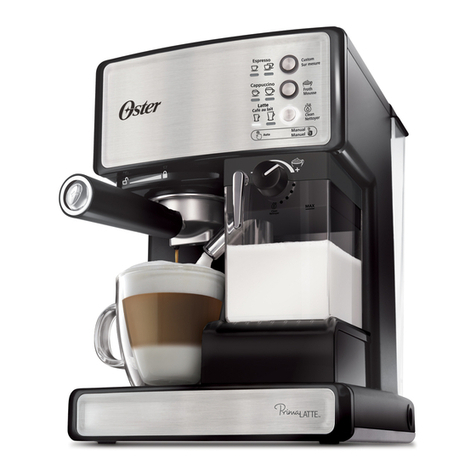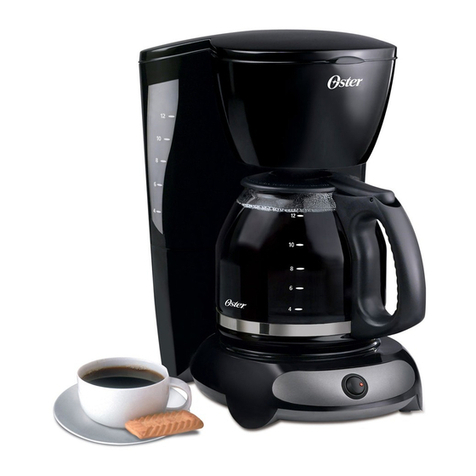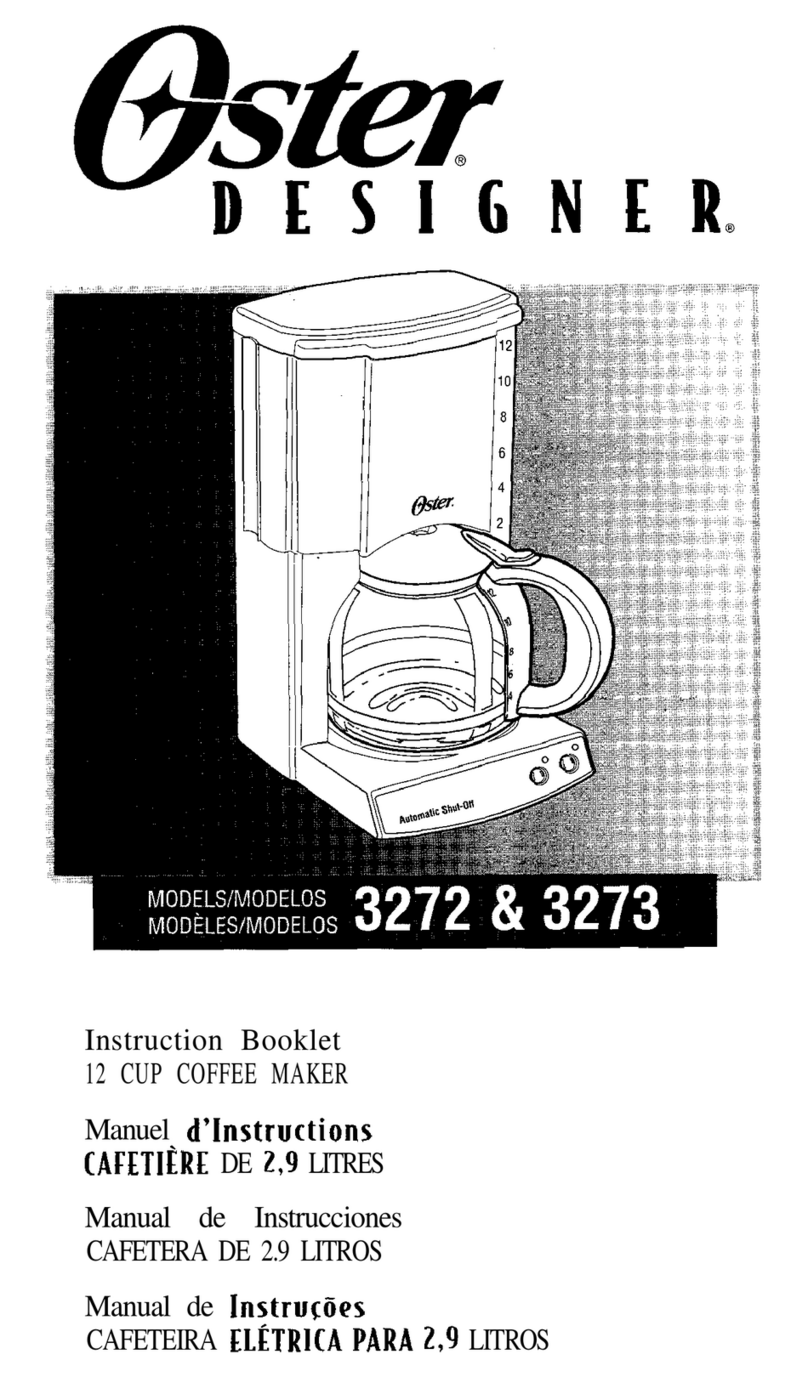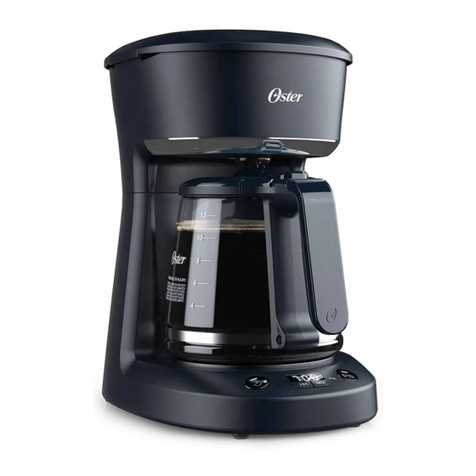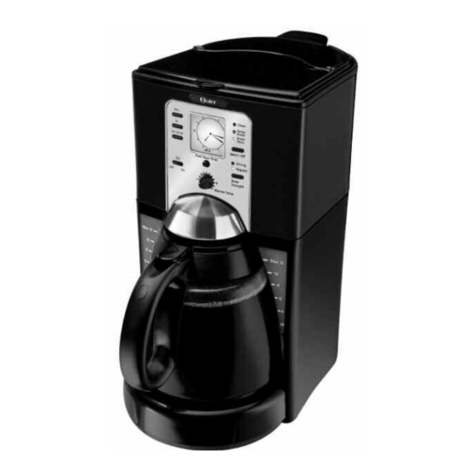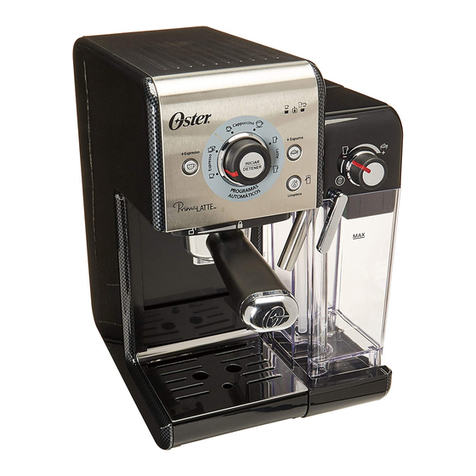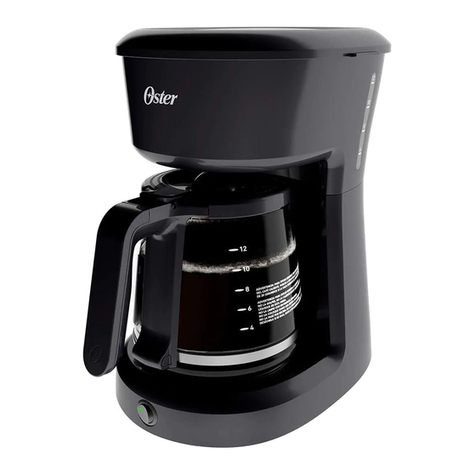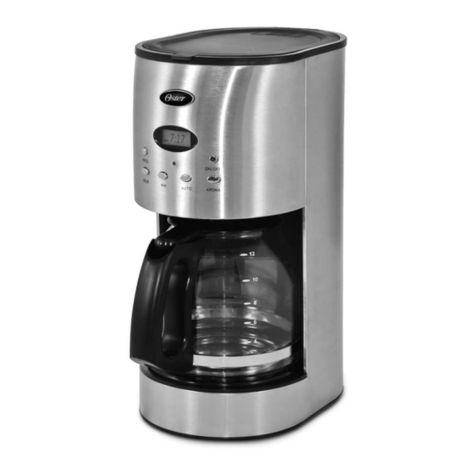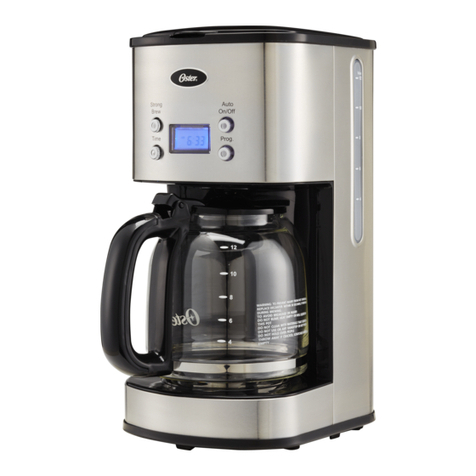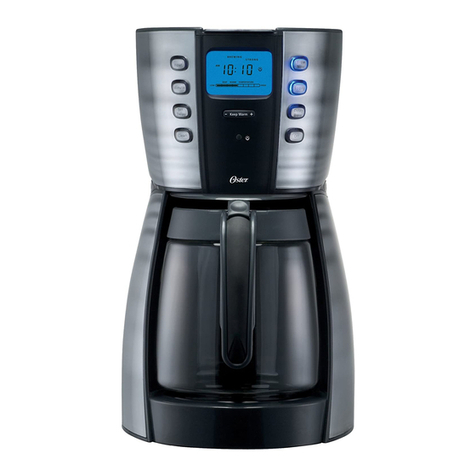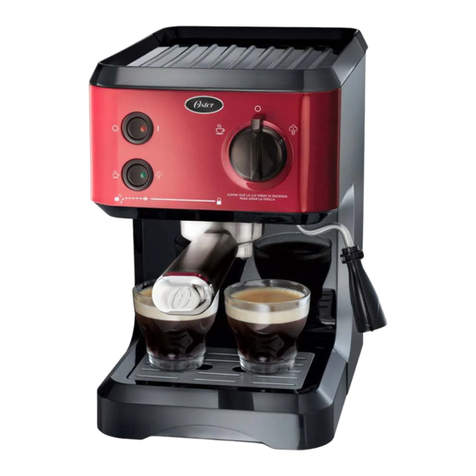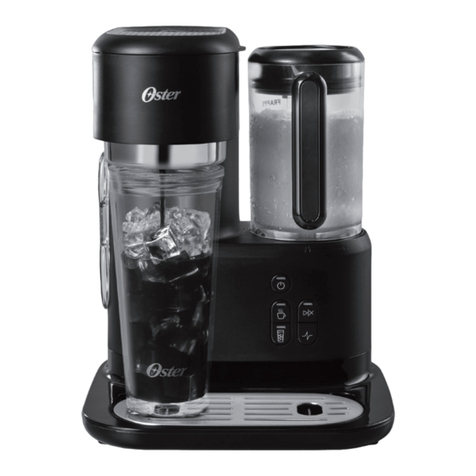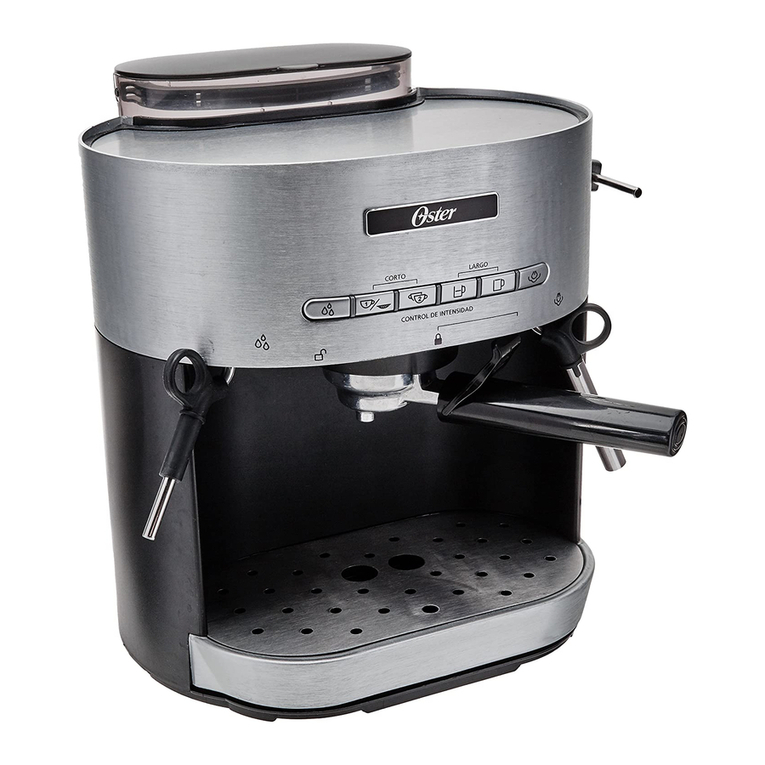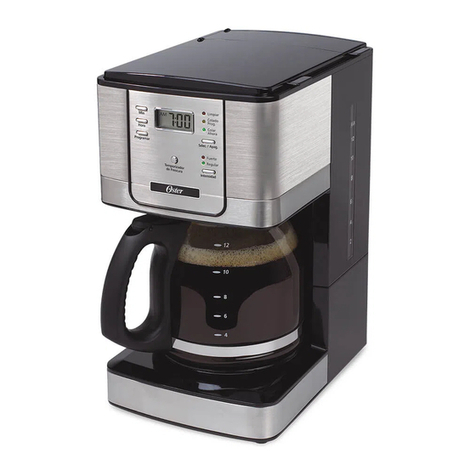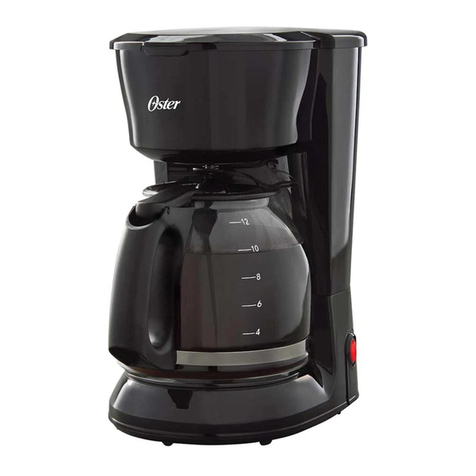
Español - 7 Español - 8
COMO PREPARAR EN CASA
CAPPUCCINOS Y MÁS
¡PRECAUCIÓN! No retire la tapa del tanque de agua ni el portafiltro hasta que libere la
presión en la unidad.
¡PRECAUCIÓN! Asegúrese de que la unidad esté desenchufada y la perilla de control
esté fijada en la posición de apagado antes de utilizar la máquina.
NOTA: Esta es una máquina manual sin función de apagado automático. Usted puede
controlar la cantidad de espresso que se cuela y por cuanto tiempo espumar la leche
girando la perilla de control.
El café cappuccino es café espresso con leche vaporizada y espuma de leche en la parte
superior. El espumar la leche para el café cappuccino requiere práctica. No se desanime
si no lo hace perfectamente la primera vez. La leche debe ser, la mitad vaporizada (la
parte inferior de la jarra) y la mitad espumosa (la parte superior de la jarra). Puede
tomarse varios intentos antes de que perfeccione este proceso.
Para mejores resultados, recomendamos espumar la leche en una jarra diferente y verter
la leche en su taza de café. La leche y la jarra deben estar frías. No use una jarra que ha
sido lavada recientemente con agua tibia.
1. El primer paso en la preparación del cappuccino es preparar el café espresso. Así
que llene la jarra de vidrio con agua fría hasta la marca designada para el número de
porciones deseadas. Nunca use agua tibia o caliente para llenar el tanque de agua.
2. Siga los pasos en la sección “COMO PREPARAR CAFÉ ESPRESSO”.
3. Llene una taza a la mitad con leche fría y colóquela junto a la máquina. La leche
descremada o del 2% es más fácil de espumar.
4. Si prepara 2 porciones, detenga la preparación de café espresso en la marca de 2
tazas. Gire la perilla de control a la posición de Apagado . Si prepara 4 porciones,
detenga la preparación de espresso en la marca de 4 tazas. Gire la perilla de control
a la posición de Apagado .
5. Usted está ahora listo para espumar y vaporizar la leche. Sostenga la jarra debajo
del tubo de vapor, de manera que el tubo de vapor esté ligeramente sumergido
en la leche. Gire lentamente la perilla de control a la posición de vapor . Mueva
suavemente la jarra en forma circular alrededor de la punta de Vaporización durante
aproximadamente 45 s. Recuerde: la leche y la jarra deben estar muy frías antes de
hacer la espuma.
6. Cuando la leche haya duplicado su volumen, o si usted está usando un termómetro
para bebidas, cuando la leche haya alcanzado los 38°C, inserte el tubo de vapor aun
más adentro de la leche para calentarla más. No caliente la leche a más de 65°C.
Para evitar salpicar leche caliente, no permita que el tubo de vapor quede por arriba
de la superficie de la leche. Después de que haya terminado de hacer la espuma,
gire la perilla de control nuevamente a la posición de apagado .
7. Usted está a listo para preparar el café cappuccino. RECUERDE: Es 1/3 de café
espresso, 1/3 de leche vaporizada y 1/3 de espuma de leche. Vierta el espresso en
una taza con capacidad por lo menos 150 ml. Después añada la leche vaporizada al
espresso y utilizando una cuchara añada la espuma.
COLOCANDO EL CAFÉ
1. Coloque el filtro en el portafiltro.
2. Llene con café recién molido finamente hasta la marca de 2 ó 4 tazas indicadas en el
filtro.
No llene más allá de la marca de 4 tazas. Limpie cualquier exceso de café del borde
del portafiltro. Esto asegurará un ajuste correcto en la cafetera.
ATENCIÓN: Comprima suavemente el café. No llene demasiado el filtro. Esto puede
causar obstrucciones o derrames.
3. Coloque el portafiltro debajo de la cabeza de preparación, coloque el portafiltro
moviendo primero el seguro hacia atrás, coloque el asa a la izquierda hasta que se
ajuste en la ranura. Después, lentamente gire a la derecha hasta que el portafiltro se
localice en la posición de cierre.
4. Verifique que la rejilla de goteo se encuentre en su lugar, sobre la bandeja de goteo.
5. Coloque la tapa sobre la jarra, para que la abertura de la tapa esté hacia el pico, y
colóquela sobre la bandeja de goteo. El asa del portafiltro y el asa de la jarra deben
estar alineadas.
6. Conecte el cable eléctrico en un tomacorriente y gire la perilla de control hacia arriba
al símbolo el cual inicia el proceso de preparación. La luz se encenderá para
indicarle que la cafetera se encuentra funcionando.
7. El café espresso comenzará a fluir dentro de la jarra en aproximadamente tres a
cinco minutos.
8. Cuando el café espresso haya terminado de fluir dentro de la jarra, gire la perilla de
control a la posición de apagado . Desconecte el cable eléctrico y permita que la
presión en la máquina sea liberada. Siga el procedimiento en la sección “CUIDADO:
PRESIÓN” de la página 4.
PRECAUCIÓN: No retire la tapa del tanque o el compartimiento del filtro en ningún
momento mientras el artefacto se encuentre bajo presión o hasta que se haya
enfriado. Siga el procedimiento marcado “CUIDADO: PRESIÓN” para liberar la
presión antes de retirar la tapa.
9. Una vez que la Cafetera se haya enfriado y que toda la presión haya sido liberada,
saque el portafiltro de la cabeza de preparación. Usando el seguro para fijar el filtro
en el soporte, gire el portafiltro hacia abajo para vaciarla. Enjuague el filtro y el
portafiltro con agua.
PRECAUCIÓN: Las partes metálicas del portafiltro pueden estar muy calientes.
Asegúrese de usar el seguro del filtro cuando deseche el café molido. Enfríe estas
partes enjugándolas bajo el chorro de agua fría.
10. Para las instrucciones de limpieza, consulte la sección “Limpieza de su máquina
despues de cada uso”.
BVSTEM3300-013_23SEM1 (LA).indd 7-8BVSTEM3300-013_23SEM1 (LA).indd 7-8 2023/6/21 09:242023/6/21 09:24
